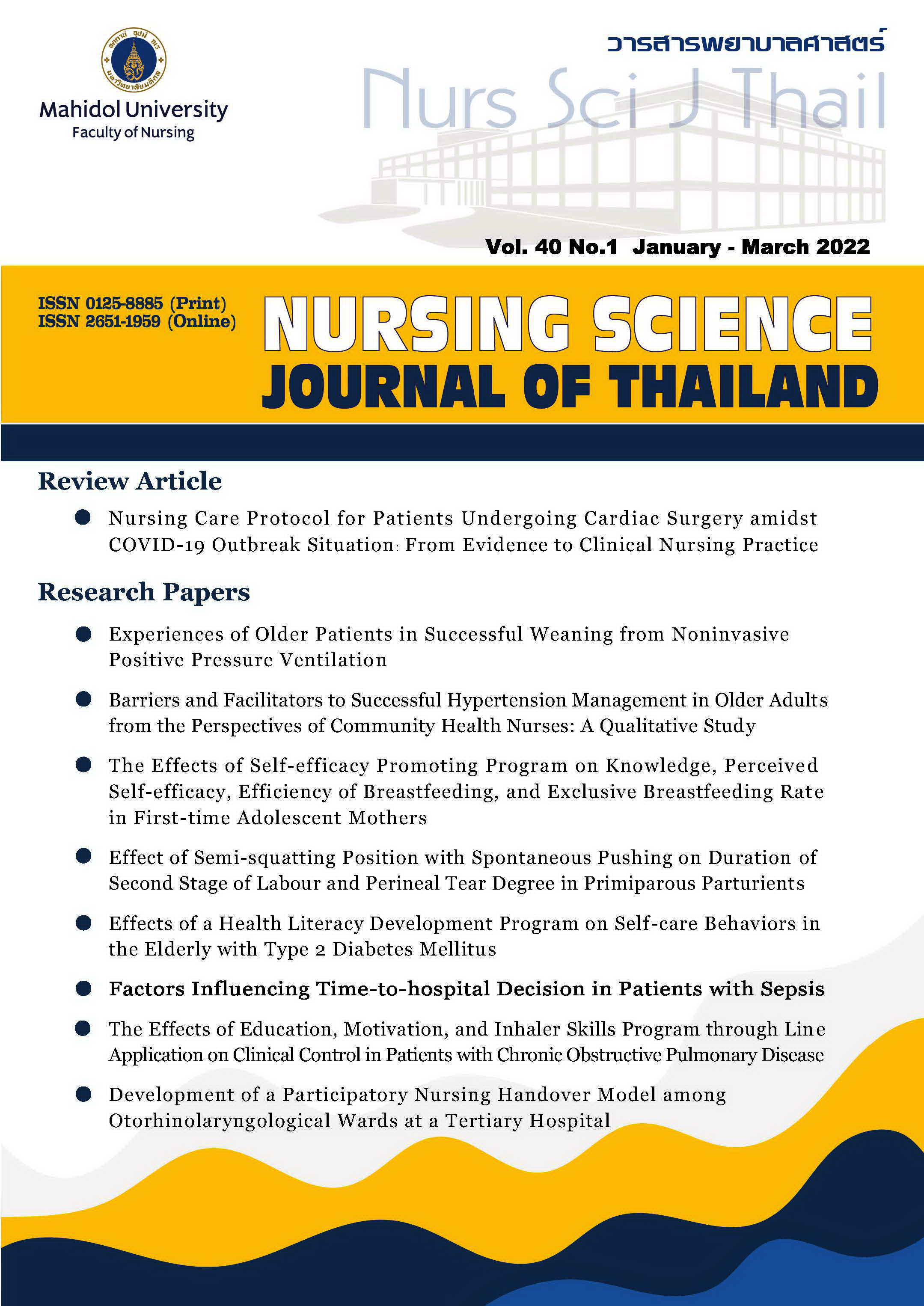Effect of Semi-squatting Position with Spontaneous Pushing on Duration of Second Stage of Labour and Perineal Tear Degree in Primiparous Parturients
Main Article Content
Abstract
Purpose: To compare the duration of second stage of labour and perineal tear degree in primiparous parturients between the group arranged in the semi-squatting position with spontaneous pushing and the group arranged in the supine position with controlled pushing.
Design: Randomized controlled trial research design.
Methods: The participants are 81 primiparous women in the labour stage at Charoenkrung Pracharak hospital. The participants were randomly assigned by a computer program into two groups: the experimental group (41) and control group (40). The experimental group was encouraged to do semi-squatting position and spontaneous pushing, while the control group was instructed to engage in dorsal recumbent position and controlled pushing according to routine nursing care. The data were collected through demographic data questionnaires and delivery record form. Descriptive statistics, independent t-test, ANCOVA, chi-square and relative risk were computed for the data analysis.
Main findings: The result showed that the duration of second stage of labour between the control and the experimental groups was not significantly different (F = .58 p = .448) when controlling for the baby weight. The perineal tears degree between the experimental and the control groups was not significantly different (p = .65). Nonetheless, more locations of tearing were significantly found in the control group (p = .009); as a result, the control group had 4.10 times greater probability of tearing (RR = 4.10; 95%CI = 1.25, 13.49) compared to the experimental group.
Conclusion and recommendations: Semi-squatting position does not shorten the duration of second stage of labour but helps reduce tearing in other areas of the birth canal. Thus, midwives should implement the semi-squatting position with spontaneous pushing as an alternative care during the second stage of labour.
Article Details
Copyright Notice: Nursing Science Journal of Thailand has exclusive rights to publish and distribute the manuscript and all contents therein. Without the journal’s permission, the dissemination of the manuscript in another journal or online, and the reproduction of the manuscript for non-educational purpose are prohibited.

Disclaimer: The opinion expressed and figures provided in this journal, NSJT, are the sole responsibility of the authors. The editorial board bears no responsibility in this regard.
References
Lertsakornsiri M. Nursing women during pregnancy and delivery. Bangkok: Assumption; 2015. 261 p. (in Thai).
Carseldine WJ, Phipps H, Zawada SF, Campbell NT, Ludlow JP, Krishnan SY, et al. Does occiput posterior position in the second stage of labour increase the operative delivery rate? Aust N Z J Obstet Gynaecol. 2013;53(3):265-70. doi: 10.1111/ajo.12041.
Cunningham FG, Leveno KJ, Bloom SL, Dashe JS, Hoffman BL, Casey BM, et al. Williams obstetrics. 25th ed. New York: McGraw Hill. 2018. 1344 p.
Cheng YW, Caughey AB. Second stage of labor. Clin Obstet Gynecol. 2015;58(2):227–40. doi: 10.1097/GRF.0000000000000113.
SomSripang P, Sornchai S. Comparison of childbirth preparation and pushing technique toward birth outcomes among nulliparous women. Nursing Journal of the Ministry of Public Health. 2014;24(1):45-55. (in Thai).
Cheng YW, Caughey AB. Defining and managing normal and abnormal second stage of labor. Obstet Gynecol Clin North Am. 2017;44 (2017):547–66. doi: 10.1016/j.ogc.2017.08.009.
Lemos A, Amorim MM, de Andrade AD, de Souza AI, Cabral Filho JE, Correia JB. Pushing/bearing down methods for the second stage of labour. Cochrane Database Syst Rev. 2017;3(3):CD009124. doi: 10.1002/14651858.CD009124.pub3.
Laughon SK, Berghella V, Reddy UM, Sundaram R, Lu Z, Hoffman MK. Neonatal and maternal outcomes with prolonged second stage of labor. Obstetric Anesthesia Digest. 2015;35(2):97-8. doi: 10.1097/01.aoa.0000463841.47692.19.
Gupta JK, Sood A, Hofmeyr GJ, Vogel JP. Position in the second stage of labour for women without epidural anaesthesia. Cochrane Database Syst Rev. 017;5(5):CD002006. doi: 10.1002/14651858.CD002006.pub4.
Desseauve D, Fradet L, Lacouture P, Pierre F. Position for labor and birth: state of knowledge and biomechanical perspectives. Eur J Obstet Gynecol Reprod Biol. 2017;208:46-54. doi: 10.1016/j.ejogrb.2016.11.006.
Yurachai M, Ratinthorn A, Serisathien Y, Sinsuksai N. The effects of directed versus spontaneous pushing on postpartum fatigue, perineal pain and childbirth satisfaction. Nursing Science Journal of Thailand. 2009;27(3 Suppl 2):27-36. (in Thai).
Gottvall K, Allebeck P, Ekéus C. Risk factors for anal sphincter tears: the importance of maternal position at birth. BJOG. 2007;114(10):1266-72. doi: 10.1111/j.1471-0528.2007.01482.x.
Suzuki S. Birthing postures and birth canal lacerations. J Matern Fetal Neonatal Med. 2017;30(10):1243-6. doi: 10.1080/14767058.2016.1209654.
Simic M, Cnattingius S, Petterson G, Sandstrom A, Stephansson O. Duration of second stage of labor and instrumental delivery as risk factors for severe perineal lacerations: population-base study. BMC Pregnancy Childbirth. 2017;17(1):72. doi: 10.1186/s12884-017-1251-6.
Nasir A, Korejo R, Noorani KJ. Child birth in squatting position. J Pak Med Assoc. 2007;57(1):19-22.
Numprasert W. A Study in Johnson’s Formula: fundal height measurement for estimation of birth weight. AU Journal of Technology. 2004;8(1):15-20.
Phumdoung S, Morkruengsai S, Tachapattarakul S, Lawantrakul J, Junsuwan P. Effect of the Prince of Songkhla University locked-upright position on the duration, pain and comfort of second stage labor in primiparous women. Pacific Rim Int J Nurs Res Thail. 2010;14(2):112-21.
Chaitikul S, Yusamran C, Serisathien Y, Ratinthorn A, Seeboonruang S. Effect of spontaneous pushing from squatting position on an innovative birthing seat on duration of the second stage of labor in primiparous parturients. Nursing Science Journal of Thailand. 2012;30(3):7-14. (in Thai).
Barasinski C, Lemery D, Vendittelli F. Do maternal pushing techniques during labour affect obstetric or neonatal outcomes? Gynecol Obstet Fertil. 2016;44(10):578-83. doi: 10.1016/j.gyobfe.2016.07.004.


